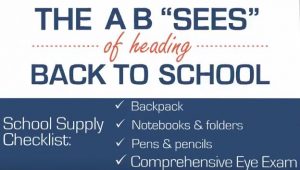THE AB – ‘SEES’ OF BACK TO SCHOOL
It’s been a great summer, but kids and parents are gearing up for a new school year. Whether it’s the first time attending preschool or kindergarten, it’s important to make Eye Exams a Back-to-School Tradition.
According to the American Optometric Association, 49% of parents have not had an eye exam on their children who are under six years of age, by an optometrist. A comprehensive eye exam is different that the eye screenings done by your pediatrician and/or school nurse.
Although a child may have 20/20 vision, they may experience a vision problem that could impact their ability to learn. Even if there are no complaints over the summer about blurry vision or headaches, children still need to have frequent eye exams. Just like their bodies are rapidly growing, children’s eyes are changing, as well.
Having clear vision is an essential part of the school experience, because so much of learning is visual. An undiagnosed eye problem could result in an academic setback in just a few short months. Some behavior problems could be linked to vision issues. These students may seem uninterested or unfocused in school when in actuality they simply cannot see clearly.
Eye issues such as strabismus (misaligned eyes), astigmatism or amblyopia (lazy eye) are also detectable through an eye exam. For some eye conditions, vision can be permanently affected if the problem is not corrected. Regular exams mean earlier diagnosis and earlier treatment.
Myopia, or nearsightedness, is a common condition in children, which often develops around the age of 6 or 7. This condition results when the cornea is curved too much or when the eye is longer than normal. When light comes into the eye, it is focused in front of the retina instead of directly on the retina and the child’s vision is blurred.
Nearsightedness can worsen rapidly, especially between the ages of 11 and 13, which means that an eye prescription can change dramatically over a short period of time. Changing eyesight is not a reason for worry, and vision tends to stabilize in the later teenage years and early twenties. During the growing years, it is important to make regular eye appointments with your child’s eye doctor. Making comprehensive eye exams a part of your back-to-school tradition guarantees that your children’s eyes are examined at least once every year.
Even a small change in vision can cause eye strain, headaches or blurred vision, which can be very distracting while in school. Staying consistent with eye exams will help your children to have clear vision and be able to concentrate and perform to the best of their ability. Start your child on the right track to learning with clear vision. From the doctors and staff at Bissell Eye Care, we wish you the best in the upcoming school year!
About the author: John D. Bissell, owner of Bissell Eye Care and Tri-State Low Vision Services, offers comprehensive eye examinations for the entire family, ocular disease detection and treatment, eye glasses, sun glasses, active wear, contact lenses, and low vision examinations for those with significant vision loss. He has undergone specialized training for treatment of low vision by the International Academy of Low Vision Specialists utilizing customized telescopic eyeglasses, prisms and telescopic implants for patients who qualify. The practice accepts most types of vision and health insurance plans.


